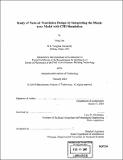Study of natural ventilation design by integrating the multi-zone model with CFD simulation
Author(s)
Tan, Gang, 1974-
DownloadFull printable version (11.01Mb)
Other Contributors
Massachusetts Institute of Technology. Dept. of Architecture.
Advisor
Leon Glicksman.
Terms of use
Metadata
Show full item recordAbstract
Natural ventilation is widely applied in sustainable building design because of its energy saving, indoor air qualify and indoor thermal environment improvement. It is important for architects and engineers to accurately predict the performance of natural ventilation, especially in the building design stage. Unfortunately, there is not any good public tool available to predict the natural ventilation design. The integration of the multi-zone model and the computational fluid dynamics (CFD) simulation provides a way to assess the performance of natural ventilation in whole buildings, as well as the detailed thermal environmental information in some particular space. This work has coupled the multi-zone airflow model with the thermal model. A new program, called MultiVent, has been developed with a web-server that can provide online calculation for the public. The MultiVent program can simultaneously simulate the indoor air temperature and airflow rate with known indoor heat sources for buoyancy dominated, buoyancy-wind combined and wind dominated cases. To properly apply the MultiVent program to the natural ventilation design, two configurations in naturally ventilated buildings should be carefully studied: the atrium and large openings between the zones. A criterion has been set up for dividing the large opening and the connected atrium space into at least two sub-openings and sub-zones. The results of the MultiVent calculation can provide boundary conditions to the CFD simulation for some particular zone. In order to correctly simulate the particular space with CFD, the location and conditions at the integrating surface (boundary surface) have been studied. This work suggested that the simulation zone should include part of the connected atrium space when (cont.) the occupied room is simulated with CFD. There are two options to integrate the MultiVent and CFD simulation through different boundary conditions: velocity (mass) integration and pressure integration. The case studies of this work showed that both of them can generate good CFD simulation results.
Description
Thesis (Ph. D.)--Massachusetts Institute of Technology, Dept. of Architecture, 2005. Includes bibliographical references (p. 150-154).
Date issued
2005Department
Massachusetts Institute of Technology. Department of ArchitecturePublisher
Massachusetts Institute of Technology
Keywords
Architecture.